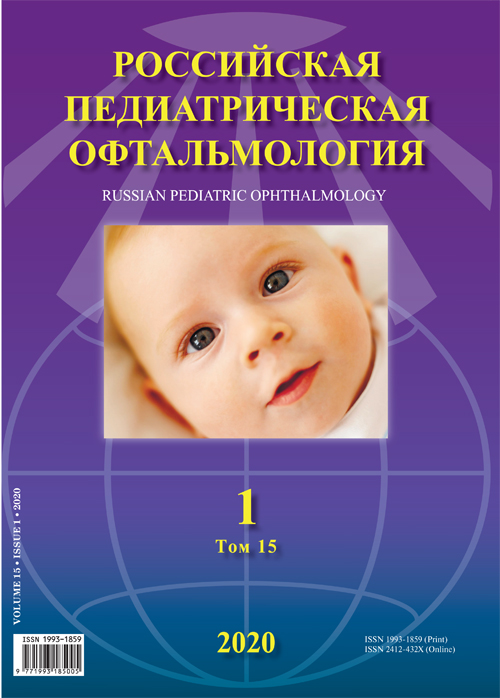卷 15, 编号 1 (2020)
- 年: 2020
- ##issue.datePublished##: 15.01.2020
- 文章: 5
- URL: https://ruspoj.com/1993-1859/issue/view/3503
- DOI: https://doi.org/10.17816/rpoj.2020.15.1
完整期次
Clinical studies
Optical coherence tomography for evaluating the retina and choroid in children with intermediate uveitis
摘要
Intermediate uveitis refers to the inflammation of the vitreous, ciliary body, and peripheral regions of the retina, and it is associated with rapid progression of macular edema and epiretinal membranes. Optical coherence tomography (OCT) examination of the retina and choroid in adult patients with intermediate uveitis demonstrates thickening in the central retina and absence of choroidal changes. Similar studies in children are lacking.
Aim: of our study was to analyze quantitative and qualitative changes in the retina and choroid in children with intermediate uveitis using OCT and to determine the possibility of using of these data for monitoring and evaluation of disease activity.
Material and methods: Twenty children with intermediate uveitis (39 eyes) aged 7–17 years were examined. In addition to standard ophthalmologic examination, all children were examined using OCT with the enhanced depth image module (EDI-OCT). The thicknesses of the retina and choroid were measured manually in the foveal zone and up to 3 mm in the nasal quadrant temporally, above, and below the fovea. Sixteen children (31 eyes) were examined for differences in disease activity and duration. The OCT examination results of the eyes of patients were compared with those of the healthy eyes (according to literature data).
Results: A significant increase in retinal thickness due to edema was observed across all measuring points in eyes with active inflammation as compared with eyes with inactive uveitis and healthy eyes. Macular edema was detected in 83% and 71% of the patients with active and moderate inflammation, respectively. Edemas were cystoid in 10% and diffuse in 90% of the patients. Analyses revealed a strong negative correlation between retinal thickness and uveitis duration. Choroid thickness varied only slightly among patients, with no significant differences across stages of inflammatory activity.
Conclusion: Our results confirm that macular edema has a higher rate of progression in children with active intermediate uveitis and that uveitis duration and central retinal thickness caused by macular edema resorption and by dystrophic processes are strongly negatively correlated. Uveitis inflammatory activity does not affect the thickness of the choroid in the central zone.
 5-14
5-14


Anatomic and topographic features of oculomotor muscles and clinical manifestations in children with vertical strabismus
摘要
Aim: To determine the anatomic and topographic features of the lateral (LRM) and medial rectus (MRM) muscles of the eyeball and clinical manifestations in children with vertical strabismus.
Material and methods: We examined 50 children aged 4–10 years with congenital squint (vertical, 38; horizontal, 12). Ophthalmologic, ultrasonography, and intraoperative studies were performed. Using the anatomic and topographic parameters of the LRM and MRM, the α angle (the angle of attachment of the tendons of these muscles) was determined.
Results: With horizontal divergence and convergence deviations of the eyeball from (±) 20 to (±) 70 prism, diopter angle α does not exceed 8°, with a combination of horizontal deviations from (±) 20 to (±) 70 and vertical deviations from 8 to 10 prism diopters and higher, the α angle varies from 10° to 20°. Moreover, the increase in the α angle is proportional to the increase in horizontal and vertical deviations of the eye. The echographic parameters of the thickness of the MRM and LRM in children with vertical and horizontal strabismus significantly exceed intraoperative ones (by 1.5–2.15 mm on average), which could be attributed to technical limitations in measurement.
Conclusion: The identified features, according to the authors, must be taken into account in surgery correction of vertical strabismus in children, that is when determining surgical dosage for resection, recession, and transposition of the horizontal muscles.
 15-23
15-23


Clinical recommendations
Novel algorithm for screening, treating, and monitoring uveitis in children with juvenile idiopathic arthritis
摘要
Uveitis is the most common extraarticular manifestation of juvenile idiopathic arthritis (JIA); if not diagnosed and treated in time, it can lead to severe complications and loss of vision. This report describes a novel algorithm for screening, treating, and monitoring uveitis in children with JIA. Ophthalmic screening of children with JIA is based on individual risk factors for uveitis. Treatment strategies include use of local glucocorticoids at the initial stage, followed by non-biological and then biological immunosuppressive drugs in severe or refractory cases. Therapy initiation and discontinuation schemes are detailed, and the need for further research is emphasized.
 36-44
36-44


Reviews
Techniques in peripheral refraction research. Literature review
摘要
Recent clinical and experimental studies have demonstrated the importance of peripheral optics of the eye in postnatal refractogenesis and the development of myopia. Considering the increased interest in the study of peripheral refraction, this literature review summarizes information on the techniques of studying peripheral refraction both in Russia and internationally.
 24-29
24-29


Review of recent publications on ways of correction of myopia and methods of control and stabilization of progression of myopia in children
摘要
This review includes the most relevant studies over the past year, devoted to the comparison of various methods of optical correction in patients with myopia and methods aimed at stabilizing the progression of myopia in children and adolescents.
 30-35
30-35











